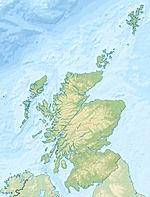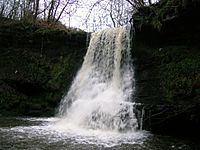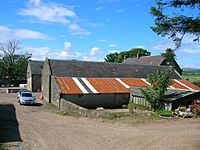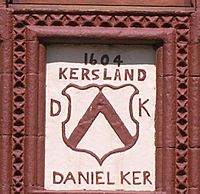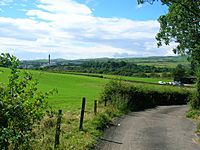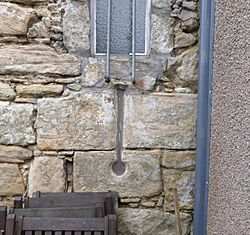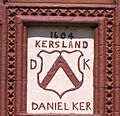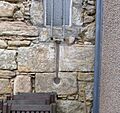The Barony of Kersland facts for kids
Quick facts for kids Kersland Manor House |
|
|---|---|
| Dalry, North Ayrshire, Scotland UK |
|
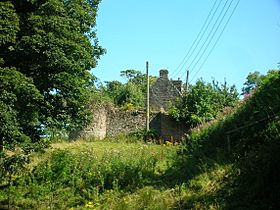
Kersland Castle and barmkin.
|
|
| Coordinates | 55°43′16″N 4°41′49″W / 55.720987°N 4.696817°W |
| Type | Tower |
| Site information | |
| Owner | Private |
| Controlled by | Clan Kerr |
| Open to the public |
No |
| Condition | Ruined |
| Site history | |
| Built | 15th century |
| In use | Until 18th century |
| Materials | Stone |
The remains of the old castle of Kersland are about 1.5 miles north-east of Dalry in North Ayrshire, Scotland. It is located in what was once the Barony of Kersland. The River Garnock flows nearby.
Contents
Discovering Kersland Castle's Past
The Kersland Barony
A "barony" was a large area of land controlled by a lord or noble. The Barony of Kersland was very big. The Kerr family owned it for over 500 years.
In the 1400s, this area had four other baronies. Kersland itself was on a hill near the River Garnock. It included several smaller areas like Kersehead and Auchengree. All together, it was about 700 acres of farmland.
The Manor House Today
The old Kersland castle or manor house stood on what is now East Kersland Farm. Parts of the original "L-Plan" tower are built into the farmhouse. An old defensive wall, called a barmkin, still stands. It even has a strong corner tower.
Much of the old house was taken down a long time ago. Two rooms with thick, curved stone ceilings remain. These rooms, with walls 8 feet thick, were once used as a dairy and a stable.
Above the main door of the farmhouse, you can see a special carved stone. It came from the old manor house. This stone shows the Ker family's coat of arms. It also has the name "Daniel Ker Kersland" and the year "1604" carved on it.
The Barony Mills
Most large land areas like baronies had a water mill. A mill was used to grind grain into flour. People living on the land had to use the laird's (lord's) mill. They paid for this service with a part of their grain. This system was called Thirlage. It ended in the late 1700s.
Kersland Mill was on the Powgree Burn, near the Tianna Falls. It is shown on old maps from around 1604. A sawmill also existed at East Kersland. It had ponds and channels to bring water to power the saws.
The Kersland Family History
The Kers of Kersland
The name "Kerse" means "low, fertile land near a river or lake" in Scottish language. The Ker (later Kerr) family owned the Barony of Kersland. The barony's name comes from them. The Kers of Kersland are thought to be one of the oldest Ker families in Scotland.
The Ker family's coat of arms had a special design. It showed a "chevron" (a V-shape) with three stars. Their family motto was "Praise God". This coat of arms was even displayed at Dalry church.
Local stories say that two sons of the Kersland family had to leave. They were involved in a fight that led to the death of a Laird of Blair. They went to England and then settled on the Scottish Border. One of these sons is said to have started the Kers of Ferniehirst family. The other started the Kers of Cessford family.
A man named William de Ker owned land in the Dalry area in 1205. His son, also William, inherited the land in 1292. He was one of the Scottish nobles who agreed to follow King Edward I of England.
Later, Robert Ker died in a big battle called Flodden in 1513. He had two sons, John and Robert. John inherited Kersland. Robert became the owner of Auchengree.
John Ker of Kersland married Lady Agnes Montgomerie in 1530. She was the daughter of the first Earl of Eglinton.
Robert Ker of Kersland then took over from his father. He married Agnes Montgomerie in 1556. They had three daughters: Janet, Margaret, and Jean. Janet Ker married Captain Thomas Crawford of Jordanhill. He was famous for capturing Dumbarton Castle from supporters of Mary Queen of Scots. Daniel, one of their sons, later took on the Ker name.
The Crawfurd Kers (Jordanhill)

Daniel Crawfurd decided to use the Ker family name and coat of arms. He married Annabella Campbell and later Isobel Drummond. Daniel and Annabella had seven children. Daniel Ker passed away in 1613.
His son, Hugh Crawfurd Ker, took over in 1613. He married Jean Blair and they had three children. One of their sons, Robert, later became a very important figure.
- Robert Kerr the Covenanter
Robert Ker was a leading Covenanter. Covenanters were a group of Scottish Presbyterians who supported their religion and opposed the King's control over the church. Because of his beliefs, Robert lost his lands. He had to leave Scotland and lived in Holland for three years.
He later returned to Scotland for business. He was captured and imprisoned in several castles, including Dumbarton Castle and Stirling Castle. After many years, he was allowed to live in Irvine with his family. However, he was again forced to flee. He returned to Holland in 1678 and died there in 1680.
The Borthwick Kers
Daniel Crawfurd, another family member, also took the Ker name. He inherited the Kersland lands. He was a soldier and died in a battle in 1692. He did not have children.
His sister, Jean Ker, inherited Kersland. She was married to Major William Borthwick. In 1697, they sold the estate to Jean's sister, Anna. Anna was married to John Crawfurd of Fergushill.
John Crawfurd then took the name John Ker of Kersland. He wrote his "Memoirs and Negotiations" before he died in 1726. He was buried in London.
John Ker had three daughters. Two of them, Anna and Jean, seemed to have never married. His daughter Elizabeth married John Campbell. Elizabeth was the last person to use the title 'Lady Kersland'. She became very poor and lived with a merchant in Beith. She was buried in the Hessilhead tomb in Beith.
In 1736, Anna and Jean had to sell the barony and property. They needed the money to pay off their father's many debts.
The Scots Family
William Scot of Bavelaw bought the barony. His son, Lawrence, divided the main Kersland lands into two farms: Easter and Wester Kersland. He rented out Easter to Robert Ker and Wester to James Kirkwood.
Lawrence's son, Charles, borrowed a lot of money. When he died in 1801, the barony had to be sold. At this time, John Smith of Swindridgemuir bought the main ownership rights.
Kersland Barony Church and School
A Church of Scotland school was located at Barkip, also known as The Den. In 1891, about 137 students attended this school. It was named after the old Kersland barony.
Local Industry
The Kersland area had several industries in the past. There were ironstone pits, which are mines for iron ore. These pits were connected by rail. There were also sandstone quarries, brickworks, and coal mines, including the Kersland Colliery. A row of houses for miners, called Kersland Row, was located near the Kersland pit.
Images for kids


